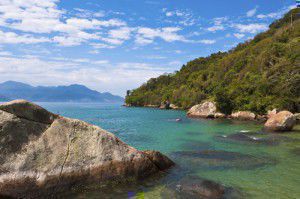Goal! around the world [Infographic]
Sometimes one word is all you need… With the World Cup getting underway today, here’s how each national team says that all-important word, ‘goal’.
You can find this and lots more in our language learning app, uTalk – available to download and start learning right now from the App Store. So whether you’re watching the football at home or away, you’ll always be prepared.
(There are lots of non-football related words in there too, for those of us with other interests!)
Please do share the infographic with friends and tell us how you’ll be shouting ‘Goal!’ this World Cup 🙂
Embed This Image On Your Site (copy code below):
10 reasons to visit… Brazil
Where else for this week’s ’10 reasons…’ post but Brazil? This huge, beautiful and unique country will be attracting tourists by the thousands over the coming weeks, so here are our top tips – whether you’re visiting for the football and have a bit of spare time, or you’re planning a holiday for later in the year.
1. Ilha Grande
A beautiful island off the coast of Rio, which can be reached by ferry (no cars allowed – there are no roads for them to drive on anyway). It’s a great place to see local wildlife, and also has a fascinating history, having been a pirates’ lair, a leper colony and a prison in its time.
2. Beaches
With over 7,000km of coastline, it’s no surprise that Brazil has a lot of beaches. It would be impossible to name them all, but a couple of the most famous are Copacabana Beach in Rio de Janeiro, which is particularly well known for its New Year celebrations, attended by about three million people each year, and Praia do Cassino, near Rio Grande in the south of the country, which is thought to be the longest beach in the world at an incredible 245km.
3. Languages
With over 180 indigenous languages, Brazil is a language lover’s dream. Although most tourists should be able to get around with a smattering of basic Portuguese, if you’re heading off the beaten track, you may hear people speaking Tupí, Arawak, Carib, and Gê languages, among many others.
4. Let’s dance!
Brazil is probably best known for samba, the African-influenced music and dance style now popular across the world, and celebrated most famously at the annual Carnaval in Rio de Janeiro. Samba is far more than just music; it’s a hugely important part of Brazilian culture, and you’d be hard pressed to visit the country without experiencing it (and why would you want to?). Capoeira is another well-known tradition, which combines dance, acrobatics and martial arts set to music. Someone once tried to teach me some capoeira moves at university. It did not go well – turns out it’s quite difficult, especially if you’re as uncoordinated as I am – but it’s great fun to watch.
5. Iguaçu Falls
Found on the border between Brazil and Argentina, the Iguaçu Falls (or Iguazu Falls if you’re in Argentina) are one of the region’s most famous natural landmarks. There are 275 waterfalls in total, along a 2.7km stretch of the Iguazu River. Be sure to see the Devil’s Throat, a U-shaped chasm right on the border between the two countries, and if you can, take a boat trip under the falls for the ultimate water ride.
6. Christ the Redeemer
Another world-famous landmark, and one of the New Seven Wonders of the World, the 124 feet high statue of Jesus Christ hit the headlines last week when travel blogger Lee Thompson was given permission to climb to the top to take a selfie. Towering over the city of Rio de Janeiro from the top of the Corcovado mountain, the monument is a must-see if you go to Brazil. Unlike Lee, you won’t be able to go inside the statue, but you can visit the chapel in the pedestal at its base and the views from the mountain are still amazing.
7. Sea Kayaking in Paraty
Staying in Rio, if you want to get away from the crowds, why not try a spot of sea kayaking in Paraty Bay? Whether you’re a beginner or an experienced kayaker, this is a great way to enjoy fantastic views of the town and mountains, relax on the beautiful sandy beaches and explore a mangrove forest on your way to the base of the Sugarloaf mountain.
8. Amazon
The rainforest, not the website. Not an area to venture into unprepared, or alone, obviously, but great if you’re tired of the cities and want to get back to nature. Take a boat trip down the river, have a treetop adventure (there’s even a hotel), or try your hand at piranha fishing (not sure about that one, personally). The rainforest is full of wildlife, although many of the animals and birds will keep themselves to themselves, so if you do encounter any, it’s pretty exciting.
9. Food
Being a huge country, Brazil has many, many types of food, from feijoada (a black bean stew with beef and sausage), to pastéis (deep fried parcels containing pretty much whatever you like – cheese, beef, cod, you name it), quindim (a custard dessert made from sugar, egg yolks and coconut) to bolinhos de chuva* (fried doughballs sprinkled with sugar and cinnamon). It’s safe to say that whatever your tastes, you’ll probably find something you like in Brazil.
* I’m tempted to go to Brazil right now for some of these.
10. Football…?
Someone told me there’s a big football tournament happening in Brazil this month, so if you’re a fan, now might be a good time to visit. I don’t know about that, but I do know Brazil are a huge footballing nation. They’ve won the World Cup (that was it!) five times, more than any other nation, and will be hoping to make it six in a few weeks. If they can get past England, obviously…
If you are visiting Brazil, remember to learn some basic Brazilian Portuguese before you go – it’ll make everything a lot easier and much more fun. Take uTalk for iOS with you and you’ll never be lost for words!
I realise I’ve barely scratched the surface of what this huge country has to offer, so if you want to share any tips of your own, please do so in the comments.
Liz
10 sport stars who speak other languages
 It can often feel like life is all about sport, whether we like it or not. But have you ever wondered how good sports stars are at languages?
It can often feel like life is all about sport, whether we like it or not. But have you ever wondered how good sports stars are at languages?
It turns out, pretty good. Like anyone who has to travel a lot for their work, athletes often find knowing only their native language isn’t enough. Here are 10 great examples of sports stars who speak more than one language.
Gary Lineker
Besides English, the former footballer learnt Spanish while he was playing for Barcelona, and picked up some Japanese when he later moved to Nagoya Grampus Eight. He’s now a passionate ambassador for languages in schools, saying in an interview with TES last year, ‘the learning of languages, for me, will always be helpful for the vast majority at some stage in their life’.
Roger Federer
Not content with winning a frankly quite ridiculous 17 Grand Slam titles, the Swiss tennis player also speaks four languages fluently – his native Swiss German along with French, English and German. He’s known for his ability to switch effortlessly between languages in interviews and press conferences and can quite comfortably answer journalists’ questions in their own language, a feat some of his fellow tennis players can’t keep up with. Wouldn’t be the first time.
Tom Daley
The British diver recently got an A in his Spanish A-level (congrats, Tom!), and makes good use of his language skills when in Mexico, where he spends a lot of his time. Here’s a video of him showing off his Spanish.
Jonny Wilkinson
Here in England, Jonny Wilkinson is known (at least by me) as that guy who’s pretty good at drop goals. But he’s also a bit of a superstar in France, where he’s been playing for Toulon since 2009. He’s now fluent in French and was awarded honorary citizenship of Toulon earlier this week – giving his acceptance speech in the local language, of course.
Fernando Alonso
The Spanish Formula One racing driver speaks an impressive four languages – Spanish, Italian, English and French. And in case that’s not enough, he’s apparently working on Russian too.
Arsene Wenger
The Arsenal manager is well known for his interest in languages, speaking French, English, German, Spanish, Italian and Japanese. Like Gary Lineker, Wenger’s also known as an ambassador for languages, and last year he was voted Britain’s first Public Language Champion by readers of The Guardian. In this video he explains why languages are so important.
Novak Djokovic
Never one to let Roger take all the glory, fellow tennis champion Novak Djokovic speaks five languages – Serbian, English, German, Italian and French. He studied English and German at primary school, and learned Italian when he worked with coach Riccardo Piati. In an interview with Tennis Talk in 2013, he said, ‘We have a saying in our country: The more languages you know, the more is your worth as a person. I like to understand what people are saying wherever I am, at least to pick up a few phrases of those languages.’
Paula Radcliffe
Long-distance runner Paula Radcliffe has a first-class degree from Loughborough University in European Studies, and speaks French and German fluently. She now lives in Monaco with her husband and two children, who are both bilingual, attending a French school but also fluent in English.
Cesc Fabregas
Another Barcelona footballer, Fabregas speaks four languages – Spanish, Catalan, English and French, and his Twitter feed is multilingual. When asked about his language skills in 2005, he replied, ‘These days you have to keep studying, not least because my mum tells me so.’ Words to live by.
Daniela Hantuchova
And finally, another tennis player, because tennis is my favourite. Daniela Hantuchova, from Slovakia, is by all accounts a very talented lady. Besides her tennis career, she’s also a trained classical pianist, and speaks – wait for it – six languages: Slovak, Czech, English and German fluently, and some Croatian and Italian.
Does anyone else feel like a bit of an underachiever now, or is it just me?
If you know any other examples of sports stars who speak other languages, please tell us about them in the comments.
The Footballer’s Hidden Skills
‘Footballers are a bit dumb.’ This is a general assumption that has existed for as long as I can remember. It also makes it a little easier when you think about the vast sums of money that most get paid. However, what would happen if they suddenly stopped receiving these large weekly amounts? This may sound a little bit of an irrelevant question but this is exactly what happened to many footballers on the continent earlier this year. With arguments about television rights in Spain many of the smaller clubs from La Liga (Spain’s equivalent to the English Premier League) owed players over three month in wages. It would have been a stark realisation for many of these young players that it did not matter if you earned €100,000 a week or €100, rent and mortgages still need to be paid on time, whether you are a footballer or not.
In this case a players’ strike at the start of the season garnered support and action for many of the affected footballers. It got me thinking however, what other attributes do these players have to use in the ‘real’ world? Could a job in languages be a realistic goal?
 If you take the Premier League for instance, there are 72 different nations represented. Now remove Britain, Ireland, America and a couple of other Commonwealth countries; that leaves representatives from 64 separate countries without English as their first language. Considering that the vast majority are now bilingual this is already an impressive item to add to their CV, but if you look at a select few they could shine in a multilingual environment:
If you take the Premier League for instance, there are 72 different nations represented. Now remove Britain, Ireland, America and a couple of other Commonwealth countries; that leaves representatives from 64 separate countries without English as their first language. Considering that the vast majority are now bilingual this is already an impressive item to add to their CV, but if you look at a select few they could shine in a multilingual environment:
Thierry Henry (NY Redbulls) – 4 – English, Italian, Spanish and French
Cesc Fabregas (Barcelona) – 4 – English, French, Catalan and Spanish
Zinedine Zidane (France) – 3 – English, Spanish and French.
The most I can seem to find, however, goes to our local Fulham centre back and Swiss international Philippe Senderos, who speaks six languages (English, French, Spanish, German, Italian and Portuguese), a total that many professional linguists would struggle to contend with.
In a small attempt to dispel the notions that the British are completely monolingual I would like to mention Gary Lineker (English, Japanese and Spanish), Owen Hargreaves (English and German), David James (English and Spanish) and Sol Campbell (English and French).
The variety of languages in the English League alone can lead to problems within teams and especially within management. Chelsea is a prime example where language skills have come to the forefront of the players’ regime. With a multitude of spoken languages, the first ruling of Andre Villas Boas (the current Chelsea manager) was to state that only English was to be spoken at the club, to bring a common language to the players who would otherwise separate into groups based on their mother tongue.
With Villas speaking four languages himself, it has become an integral part of his management style. New Spanish signing Juan Mata stated that understanding the instructions in English is challenging to begin with, but the squad helps out any new team mates who are struggling. With personal problems, however, Mata says that the manager would take him to one side and have any personal conversations in Spanish to allow him to fully express himself; this demonstrates the diversity an extra language can give, especially in management roles.
There is one English based Chelsea induction that the Spaniard could not escape – the tradition of Chelsea’s karaoke initiation, where a song has to be sung in English in front of the entire squad. Mata’s choice? The Macarena… It seems that although we may not be able to write off footballers as talentless off the pitch, due to the language skills that many have learned, we may be able to continue with the assumption that they have some terrible taste.
Glyn




